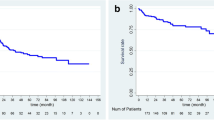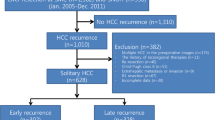Abstract
Background and objectives
Hepatic resection is established as the treatment for HCC. However, patients sometimes experience early recurrence of HCC (ER HCC) after curative resection.
Methods
A retrospective analysis was conducted for 193 patients with single HCC who underwent curative liver resection in our medical center between April 2000 and March 2013. We divided the cohort into two groups; early recurrence group (ER G) which experienced recurrence within 6 months after resection, and non-early recurrence group (NER G). Risk factors for ER HCC were analyzed.
Results
Thirty-nine out of 193 (20.2 %) patients had ER HCC. Univariate analysis showed Glasgow prognostic score (GPS, p = 0.036), neutrophil to lymphocyte ratio (NLR, p = 0.001), level of PIVKA-II (p = 0.0001), level of AFP (p = 0.0001), amounts of blood loss (p = 0.001), operating time (p = 0.002), tumor size (p = 0.0001), stage III and IV (p = 0.0001), and microvascular invasions (portal vein: p = 0.0001 and hepatic vein: p = 0.001) to be associated with ER HCC. By multivariate analysis, there were significant differences in high NLR (p = 0.029) and high AFP (p = 0.0001) in patients with ER HCC.
Conclusions
Preoperative high AFP (more than 250 ng/ml) and high NLR (more than 1.829) were independent risk factors for ER HCC.


Similar content being viewed by others

References
Kudo M, Izumi N, Kokudo N et al (2011) Management of hepatocellular carcinoma in Japan: consensus-based clinical practice guidelines proposed by the Japan Society of Hepatology (JSH) 2010 updated version. Dig Dis 29(3):339–364
Bruix J, Sherman M (2005) Practice Guidelines Committee AAftSoLD. Management of hepatocellular carcinoma. Hepatology 42(5):1208–1236
Lim KC, Chow PK, Allen JC et al (2012) Systematic review of outcomes of liver resection for early hepatocellular carcinoma within the Milan criteria. Br J Surg 99(12):1622–1629
Shirabe K, Kanematsu T, Matsumata T et al (1991) Factors linked to early recurrence of small hepatocellular carcinoma after hepatectomy: univariate and multivariate analyses. Hepatology 14(5):802–805
Poon RT, Fan ST, Lo CM et al (2002) Long-term survival and pattern of recurrence after resection of small hepatocellular carcinoma in patients with preserved liver function: implications for a strategy of salvage transplantation. Ann Surg 235(3):373–382
Sohn W, Paik YH, Kim JM et al (2014) HBV DNA and HBsAg levels as risk predictors of early and late recurrence after curative resection of HBV-related hepatocellular carcinoma. Ann Surg Oncol 21(7):2429–2435
Zhu WJ, Huang CY, Li C et al (2013) Risk factors for early recurrence of HBV-related hepatocellular carcinoma meeting milan criteria after curative resection. Asian Pac J Cancer Prev 14(12):7101–7106
Li T, Qin LX, Gong X et al (2014) Clinical characteristics, outcome, and risk factors for early and late intrahepatic recurrence of female patients after curative resection of hepatocellular carcinoma. Surgery 156(3):651–660
Ishizuka M, Kubota K, Kita J et al (2012) Impact of an inflammation-based prognostic system on patients undergoing surgery for hepatocellular carcinoma: a retrospective study of 398 Japanese patients. Am J Surg 203(1):101–106
Walsh SR, Cook EJ, Goulder F et al (2005) Neutrophil-lymphocyte ratio as a prognostic factor in colorectal cancer. J Surg Oncol 91(3):181–184
Gomez D, Farid S, Malik HZ et al (2008) Preoperative neutrophil-to-lymphocyte ratio as a prognostic predictor after curative resection for hepatocellular carcinoma. World J Surg 32(8):1757–1762
Ishizuka M, Oyama Y, Abe A, Kubota K (2014) Combination of platelet count and neutrophil to lymphocyte ratio is a useful predictor of postoperative survival in patients undergoing surgery for gastric cancer. J Surg Oncol 110(8):935–941
Feng JF, Huang Y, Chen QX (2014) The combination of platelet count and neutrophil lymphocyte ratio is a predictive factor in patients with esophageal squamous cell carcinoma. Transl Oncol 7(5):632–637
McMillan DC (2013) The systemic inflammation-based Glasgow Prognostic Score: a decade of experience in patients with cancer. Cancer Treat Rev 39(5):534–540
Liao R, Tang ZW, Li DW et al (2015) Preoperative neutrophil-to-lymphocyte ratio predicts recurrence of patients with single-nodule small hepatocellular carcinoma following curative resection: a retrospective report. World J Surg Oncol 13:265
Makuuchi M, Hasegawa H, Yamazaki S (1985) Ultrasonically guided subsegmentectomy. Surg Gynecol Obstet 161(4):346–350
Zhou YM, Yang JM, Li B et al (2010) Risk factors for early recurrence of small hepatocellular carcinoma after curative resection. Hepatobiliary Pancreat Dis Int 9(1):33–37
Du ZG, Wei YG, Chen KF, Li B (2014) Risk factors associated with early and late recurrence after curative resection of hepatocellular carcinoma: a single institution’s experience with 398 consecutive patients. Hepatobiliary Pancreat Dis Int 13(2):153–161
Tangkijvanich P, Anukulkarnkusol N, Suwangool P et al (2000) Clinical characteristics and prognosis of hepatocellular carcinoma: analysis based on serum alpha-fetoprotein levels. J Clin Gastroenterol 31(4):302–308
Poon RT, Fan ST, Ng IO et al (2000) Different risk factors and prognosis for early and late intrahepatic recurrence after resection of hepatocellular carcinoma. Cancer 89(3):500–507
Shimoda M, Katoh M, Kita J et al (2010) The Glasgow Prognostic Score is a good predictor of treatment outcome in patients with unresectable pancreatic cancer. Chemotherapy 56(6):501–506
Ishizuka M, Kubota K, Kita J et al (2011) Usefulness of a modified inflammation-based prognostic system for predicting postoperative mortality of patients undergoing surgery for primary hepatocellular carcinoma. J Surg Oncol 103(8):801–806
Li C, Wen TF, Yan LN et al (2015) Postoperative neutrophil-to-lymphocyte ratio plus platelet-to-lymphocyte ratio predicts the outcomes of hepatocellular carcinoma. J Surg Res 198(1):73–79
Peng W, Li C, Wen TF et al (2014) Neutrophil to lymphocyte ratio changes predict small hepatocellular carcinoma survival. J Surg Res 192(2):402–408
Mano Y, Shirabe K, Yamashita Y et al (2013) Preoperative neutrophil-to-lymphocyte ratio is a predictor of survival after hepatectomy for hepatocellular carcinoma: a retrospective analysis. Ann Surg 258(2):301–305
Yamamura K, Sugimoto H, Kanda M et al (2014) Comparison of inflammation-based prognostic scores as predictors of tumor recurrence in patients with hepatocellular carcinoma after curative resection. J Hepatobiliary Pancreat Sci 21(9):682–688
Author information
Authors and Affiliations
Corresponding author
Rights and permissions
About this article
Cite this article
Shimoda, M., Tago, K., Shiraki, T. et al. Risk Factors for Early Recurrence of Single Lesion Hepatocellular Carcinoma After Curative Resection. World J Surg 40, 2466–2471 (2016). https://doi.org/10.1007/s00268-016-3529-7
Published:
Issue Date:
DOI: https://doi.org/10.1007/s00268-016-3529-7



